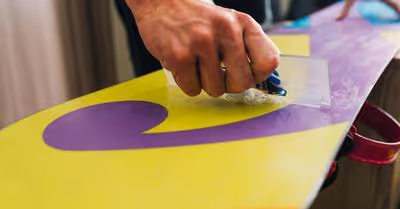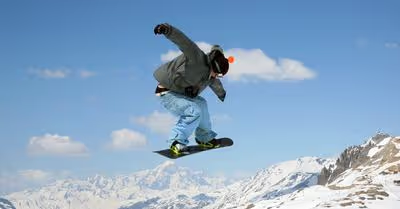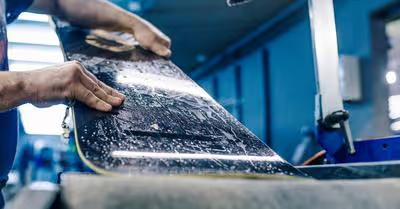Table of Contents
Why Do Snowboard Boots Lean Forward?
Snowboard boots are important for the performance of your tricks. You can use them to make your turns more stable and for balance. They also protect against injury.
They come in different sizes, shapes, and materials but the most critical aspect of your snowboard boot design is the amount of forwarding lean. This is a must-have when riding, but the key is to find a boot with the perfect angle for you.
The reason snowboard boots are made with a forward lean angle is to allow snowboarders to obtain better positioning. This is done by creating a more natural knee bend in your stance with reduced toe drag.
By creating less resistance, snowboard boots can eliminate unneeded extra energy to enter into turns so carving is much more natural and smooth. You need to find boots with enough forward lean so you can get the most from your snowboard too.
What If My Snowboard Boots Don’t Lean Forward Enough?
If your snowboard boots do not have enough forward lean, adjustments can be made with your bindings to get to an optimal angle that suits you best. The fit of your snowboard boots is also a determining factor when adjusting your forward lean.
Boots that don't lean enough can cause pain in your feet and ankles, as well as pressure on your knees and back. When you're snowboarding, it can be difficult to turn or stop if your boots don't lean forward enough too.
Forward lean will cause a natural bend in your knees while on your board, so without it, you are forced to position yourself in an uncomfortable stance. If you ever feel like you need more forward lean, you can adjust your bindings to get the perfect stance for your riding needs.
Some riders also find that their boots are not leaning forward enough which can cause discomfort in different areas of the foot and calf. It is a reliable way to improve the feel of your boots for more comfort.
Benefits Of Snowboard Boots That Lean Forward
Snowboard boots not only determine your comfort levels on the mountains, but it also impacts performance too. There are several advantages to buying snowboard boots that lean forward.
Reduced Toe Drag
The boots lean forward to reduce the toe drag, which helps with snowboarding. The boots are also designed for a more stable ride.
The boots are designed for a stable ride and less effort on the board. They are made for experienced snowboarders who know how to use their toes to control their balance. The boots are commonly used with freestyle tricks of all levels, including nollie jumps, kickflips, grabs, and board slides.
The toe drag of snowboard boots can be reduced through the design of the boot. This is because by leaning forward, you can reduce the toe-strike forces on your board.
Improved Balance
Snowboard boots that lean forward will provide improved balance because you naturally bend your knees while riding your board.
Snowboard boots that lean forward will provide increased comfort and stability for snowboarding and improve balance and performance.
While snowboarding, you have to balance on your board and lean forward to steer. This leans your body weight on your arms and legs which compresses your spine and provides a level of support.
Each time you lean forward, the boots would cause a shift in the pressure on the leg which in turn will help improve balance. Snowboard boots that lean forward will provide improved balance because you naturally bend your knees while riding your board.
The unique shape of the boot's footplate promotes a natural stance for leaning forward when balancing with minimal effort from the rider. This equates to higher performance with minimal effort from the rider.
More Precise Heelside Turning
Snowboard boots that lean forward will provide more precise heelside turning for advanced carving ability on a snowboard. The extra, more precise heelside turning is caused by increased pressure of your weight on the outside edge of the snowboard boot's sole.
This increased pressure is due to more weight on the outside edge, which brings your foot closer to parallel with the ground plane. When you are parallel with the ground plane, it is easier to turn than when you are turned out of line with it.
The heel side turning of a snowboard is an advanced move and is most effective when the rider has a good amount of power and balance in their legs. Snowboard boots that lean forward will provide more precise heelside turning for advanced carving ability on a snowboard.
The features that provide these benefits include the ability to lean forward on steep terrain, or when approaching gates, rails, or other objects that you want to avoid. The features also allow the rider to initiate turns without having to stop and turn their legs before they initiate the turn.
How To Adjust The Forward Lean On Your Snowboard
The forward lean is an adjustment that can be made to a snowboard so that it is more maneuverable on the slopes. If you find that your boots don’t lean forward enough, you can also follow these steps to adjust the lean on your bindings.
1. Determine The Type Of Lock On Your Bindings
To properly adjust the board, one should identify if their board is a twist-lock or flip-lock before making adjustments. Once this has been identified, you can adjust the bindings depending on your unique lock type.
Both of these are the ideal settings and come on a majority of the binding types, but if you have a more complex locking solution you may need to use a screwdriver and remove screws to make necessary adjustments.
2. Unlock Your Bindings
Now you need to unlock your bindings completely so they are free for movement to make the adjustments to the angle they will rest at. Many bindings will even have specific preset settings so you can automate it a bit.
The flip-lock binding is the easiest to adjust and only takes a few clicks to have your bindings set up in a forward lean.
3. Adjust The Position Of Your High Back
When the binding is unlocked, you should focus on adjusting the high back to the correct position. The exact amount of forward lean will vary based on rider preference, so you should learn about the angles and how much pressure you want to put on your front leg.
Once determined, you can move the high back into the desired angle. Push it forward into place and test it out a few times before locking it into place permanently.
4. Lock The Binding At Your Desired Angle
When adjusting your angles, make sure that there's enough room between the heel edge of your boot and where the toe piece starts on your heel edge without applying too much pressure against each other.
You can finish off the adjustment by locking the binding at your desired forward angle so they are ready for use again.
Recent Articles
















